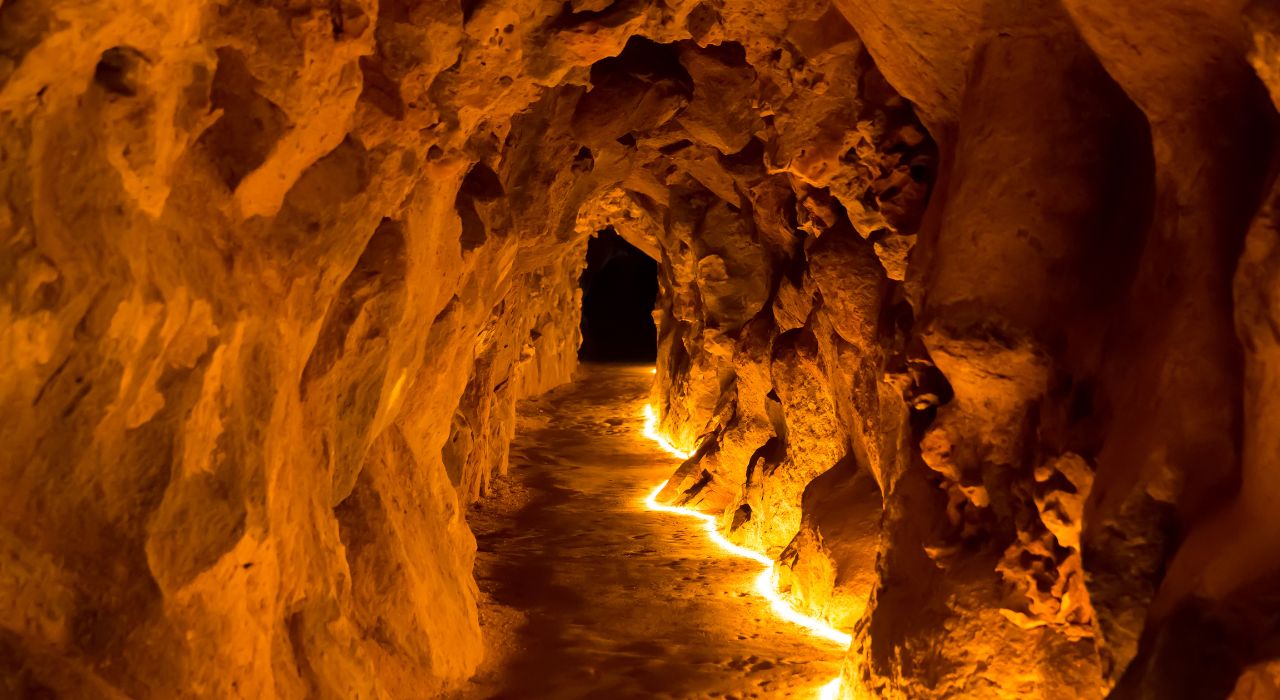
Today, few dare to penetrate deep into the earth – beyond the once habitable entrance caves, which, in fact, are only the threshold at the beginning of the endlessly deep, mysterious and unexplored labyrinths leading to the heart of this planet. But the first people, our infinitely distant ancestors, found refuge there, in caves. Stone walls sheltered them from animals, rain, snow, cold and heat. Over time, humanity learned to build artificial walls and forgot about its first house.
To begin with – a little lyrics. Cave – there are drops of water hitting the eternal stone, the echo of the ringing of your equipment, disappearing in the darkness of the well, stones creaking against each other mixed with clay and the cold that awaits you during stops. And also a cave – these are smells. Lots of smells: rotting wood, damp moss, earth – all this is mixed in the humid and sterile air into one strange, seemingly emasculated, but still felt the spirit, which first meets you at the entrance to the dungeon.
On the way back, already at the very surface, your nose suddenly begins to feel something that you never notice in normal life – the pungent smell of ozone, the thick aroma of herbs and flowers dried in the sun (if it’s summer above) or the creaking aroma of stale snow (if it’s winter). But this gift must be earned because a cave is also work, often hard, drying, turning a person into an empty, taciturn, stupefied shell, for which the main thing is – to lean against something and switch off for at least a few minutes.
Cave – this is squeezing through cracks, going up and down on a rope, monotonously dragging transport bags that become heavier every hour, digging in rubble, topographic survey. And then – an underground base camp, where the exhausted body tries to fall asleep, but cannot, because around – cold, hard stone and most importantly – drops The ringing impacts of droplets, giving rise to a racket in which ears, confused by the lack of familiar sounds, begin to discern either human talk, the sound of footsteps, or distant singing. However, even such a rest restores strength well. After that – getting up, breakfast and a damp, cold wetsuit.
What is missing on the surface for those who happily exchange days of honestly earned vacation for all these ordeals?

It’s subconscious. This is a pursuit of such strange spiritual comfort that a person finds while underground. Some people like to discover the unknown by making first ascents. Underworld – the only place left on our planet where the absolute limit has not yet been reached. The highest mountain we know – Everest. The deepest point of the world’s ocean is also – the Mariana Trench. And underground, record-breaking caves change regularly, and the deepest is now – Voronya-Krubera, in Abkhazia, which may, in a couple of years, give up its leadership to some other cave.
Someone wants to tickle their nerves once again. As a rule, these are beginners going to the cave for the first or second time. They also think that speleology is “extreme”, and fears – heights, darkness, cold – pleasantly tickle your nerves. An experienced speleologist can be nervous at the very beginning, until the moment when the descender is not yet fastened into the rope, and after that, all extraneous thoughts fly out of his head: work has begun, and teamwork at that – There are practically no loners in speleology.
The main thing in the cave, it seems to me, is what other types of activity cannot give a person – a sudden, complete and unconditional change of situation.
The underground world is unusual for the modern man. In the kingdom of cold and darkness, an organism accustomed to a huge flow of information – audio, visual, tactile, olfactory – becomes as if stunned. He doesn’t have enough data. This is unusual, and therefore, even just being underground – without hard work – is already stressful and, at the same time, oddly enough, the best way to unwind, forgetting for a while about all the problems and worries left on the surface.

And the last thing, which I think is very important for a speleologist – instant change of spatial coordinates of habitat.
But, in ordinary life, we exist, as they say, on a plane. We walk in a straight line, with our feet, in large spaces. This teaches a person to perceive his “I” as some abstract thing. Europeans, for example, when thinking about themselves, first of all, imagine the head, the brain, and Asians – the heart. But in both cases, a person does not feel the clear boundaries of his body.
And now you find yourself underground. There are practically no flat surfaces here. You have to walk, crawl, climb and at the same time constantly think about how to overcome the next narrowness: right side, left, head up or down.
Gradually, the speleologist develops a clear idea of the boundaries of his body. The kind of physicality that allows you, at one glance at the narrowness, to figure out how to place the protruding parts of the body in it, how to bend and where to exhale. I don’t know how to consider this phenomenon from a philosophical and psychological point of view, but it exists (there’s no escape from it).
And the caves are also beautiful. And the wealth of forms of various leaks – stalactites, stalagmites, carolines, helictites, etc. – It’s not even the main thing here. While working, you don’t always perceive these beauties – only the most noticeable and obvious ones. But a speleologist can admire the grandeur of a gigantic, the size of several stadiums, underground hall, who knows how formed at a depth of several hundred meters. It’s really very beautiful.
Now – the practical part.
Underground cavities are generally divided into two types – natural (appeared as a result of the influence of any natural forces) and artificial (created by man). People who explore the former are called speleologists or cavers. Fans of man-made caves – quarries, mines, underground city communications, etc. – They are called speleologists and diggers. Most natural caves are the result of a process of washing away soluble rocks from harder rocks. This process is named after the area in which it was first described – Karst.
The deepest karst cave to date is located in Abkhazia.

This – Voronya-Krubera mine. Its depth – 2140 meters. The longest cave in the world – Flint-Mamontova. It is located in the US state of Kentucky. Its length – 535 kilometers. On the territory of the former USSR, the most popular speleological areas – were Crimea (shallow, very beautiful and comfortable caves) and the Caucasus (sport-type caves, usually very cold, watered and deep). In addition, there are a number of famous areas in the Urals and Central Asia.
There are about ten caving clubs and teams in Moscow that unite cave explorers. Throughout Russia, there are relatively few caving communities – no more than a couple of dozen, but active speleologists – several hundred.
A complete set of speleological equipment includes a helmet, an acetylene flashlight, a pair of ordinary electric flashlights, rubber boots, special thermal underwear or a tight-fitting isothermal, a wetsuit made of thin rubber, a durable advising or plastic suit, a speleological harness, a long and a whole bunch of pieces of iron. (derailleurs, crawlers, carabiners, etc.) designed to facilitate and maximize the safety of the process of moving along the rope. This is personal equipment only. You will also need a rope and a kit for hanging it (this is, as a rule, club equipment purchased as a treasure). If work underground takes more than a day, then an underground base camp is established – a low tent and warm sleeping bags plus a kitchen set.
Special mention must be made of cave diving to explore passages flooded with water. This is a separate and very dangerous cuisine, standing halfway between speleology and serious diving.

Trying caving is very easy. “Beach” option – visiting a cave equipped for excursions. The most famous – Red or Marble in Crimea, as well as New Athos in Abkhazia. In addition, several travel companies in Crimea offer guided tours to unequipped caves. A more labour-intensive option – joining a caving club. The path of a novice speleologist is as follows: several months of mastering the technique of rope climbing in the city, then a training “school” trip to the Crimea or the Caucasus. After the first expedition, it usually becomes clear who is a random person in speleology and who will continue to do it in the future.
In the near Moscow region, there are a number of artificial cavities – quarries. A visit to them, of course, will give a certain idea of the underground world, but, according to many speleologists, these quarries cannot stand any comparison with classic vertical karst cavities. In contrast, a completely different thrill, but more on that some other time.








